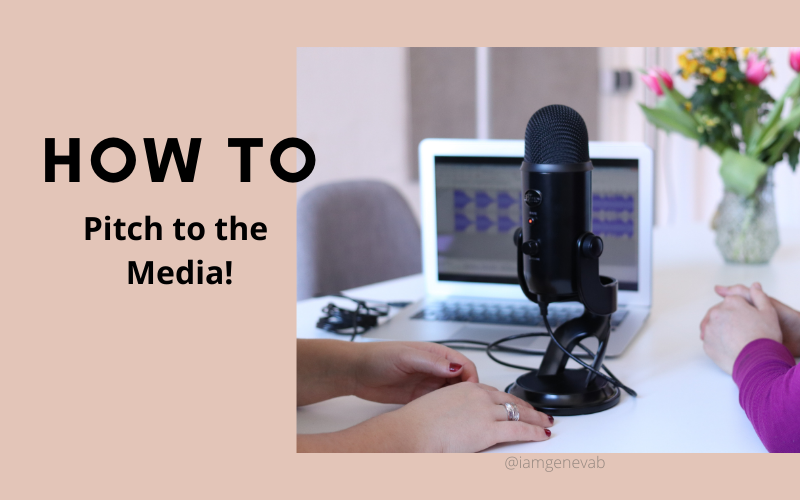So you are a solo-entrepreneur or a small business owner and you have a great product or service that you’d like to share with the world. Wouldn’t it be nice to have a featured story in your local newspaper or better yet, a national magazine?
Perhaps there is something unique about your brand that you’d like to pitch to media. You could hire an independent publicist or a boutique public relations firm but maybe your marketing budget is a bit tight right now and you’d like to do it yourself, or at least give it a try. There’s nothing wrong with that.
In fact, I usually encourage people to learn more about the service that they want to outsource. This means that you need to take the time to learn how to do that service yourself. Gary Vaynerchuk calls this being a “practitioner” in the service you want to hire someone else to do. This helps you in two ways.
NEED HELP PITCHING TO MEDIA?
If you’re serious about getting your brand out there and you’re ready to pitch to media, I’m here to help. Book a call with me today!
Number one, you get hands-on experience and you can gauge the difficulty level for yourself. Maybe it’s not necessary to outsource but then again, maybe it is.
And two, it’s a little harder for people to take advantage of you if you know exactly what they need to do and how they go about doing it. How awful would it be to be billed for hours of work that should have taken only a few minutes? It happens.
The best illustration I can think of is when you go to an auto mechanic and need to trust that the mechanic will be honest about the work that needs to be done on your vehicle. When you know absolutely nothing about cars or what’s under the hood of your vehicle, it’s easy to be taken advantage of.
In this article, we’re going to discuss five steps you need to take in order to pitch to media the right way.
Table of Contents
Step One: Before You Pitch to Media, Know Your Audience
Step Two: Before You Pitch to Media, Learn More About Each Media Outlet
Step Three: Before You Pitch to Media, Prepare Extremely Well
Step Four: When You Pitch to Media, Keep It Brief
Step Five: When You Pitch to Media, Think Long Term
Final Thoughts
Step One: Before You Pitch to Media, Know Your Audience
If you have an online jewelry store and want to get your products in front of more customers, you have to consider where your audience will be. Would you pitch to BroBible, a website whose readers are men between the ages of 18 and 34?
Yes actually, you would. Especially if your jewelry is specifically for men but even if they are strictly for women, you can still pitch. It’s all about pitching the right story angle. Your pitch could be something like, “Gift Ideas For Your Mom, Girlfriend, Wife, etc.” You get the idea.
However, you want to focus primarily on your target audience so you may want to pitch to Marie-Claire, StyleBlazer, or other similar publications.
First, find out which publications may appeal to your target audience and then add those publications to your pitch list.
NEED HELP PITCHING TO MEDIA?
If you’re serious about getting your brand out there and you’re ready to pitch to media, I’m here to help. Book a call with me today!
Step Two: Before You Pitch to Media, Learn More About Each Media Outlet
Whether you’re pitching to a radio or podcast show, a television or web show, a magazine, or a newspaper you need to tailor your pitch to that specific media outlet. This is one of the reasons why I recommend keeping your list small, to begin with. Start out with no more than 20 media outlets.
Check out their websites, see if they have an editorial calendar available. This is helpful because it allows you to see what topics they will focus on each month. This gives you the advantage of planning ahead and pitching trendy and unique story angles that fit what they want to cover.
Many magazines will have their masthead available as well. This way you can see who the editors and writers are and possibly their email addresses.
It may be difficult checking out the websites on these media outlets to find out who the correct person to contact is. That’s why I love LinkedIn.
I usually look for editors, writers, freelance writers, producers, etc., all on LinkedIn.

Step Three: Before You Pitch to Media, Prepare Extremely Well
Most journalists are juggling extremely busy schedules and typically have multiple deadlines and are under a ton of pressure. You don’t want to waste their time pitching them a story that you don’t have all of the details on.
For example, you are having a grand opening in the near future but aren’t sure of the exact date because you’re still waiting on the contractors you hired to finish the work that needs to be done.
Be ready with all of the stats, details, photos, quotes, case studies, and spokespeople. Have everything in order and on standby when the journalist asks for them.
Step Four: When You Pitch to Media, Keep It Brief
Trust me, I know how much you want to tell the producers or journalists every little detail of your pitch. If may feel that if you leave any bit of it out, that will almost guarantee that your story won’t make the cut.
I’m here to tell you that it doesn’t matter. If they are interested in your pitch they will know, whether you give them every little detail or not. If they ask questions wanting to learn more about your pitch, well, that’s a good sign.
When pitching your story to a media outlet via email, make it brief. Cision lists offering a wall of text as one of three scary mistakes that make press releases spooky. Just put yourself in their shoes. Would you read a long wordy email from someone you don’t know?
If you end up having a phone or in-person conversation with them, try to think of the meeting as an elevator pitch. Keep the important parts, be clear and concise. But above all, be respectful of their time.
Step Five: When You Pitch to Media, Think Long Term
Be prepared for rejection because it will absolutely happen, probably most of the time in the very beginning. However, don’t get discouraged. Keep those relationships going. Look at the positive side, now they know who you are.
Send them a handwritten thank you note for their time. Connect with them on LinkedIn and follow them on Twitter. You can always tailor your pitch or come up with a unique story angle and pitch it to them again in the future.
What you don’t want to do is bug them. That will quickly get you on their “person I need to avoid at all cost” list and you don’t want that. Don’t be creepy, just keep it casual and try again when the time is right.
I’ve gotten my clients featured in Latina Magazine, Huffington Post, Business Journals, NBC 6 In The Mix, Telemundo and the list goes on. It certainly wasn’t a piece of cake but I learned that developing those relationships with producers, editors, and writers is the most important thing you can do.
Final Thoughts
With proper planning, you can have really good success pitching to media and receiving media placements for your brand. For more advice, guidance, or help pitching your business to media outlets, don’t hesitate to reach out to me.
NEED HELP PITCHING TO MEDIA?
If you’re serious about getting your brand out there and you’re ready to pitch to media, I’m here to help. Book a call with me today!




0 Comments